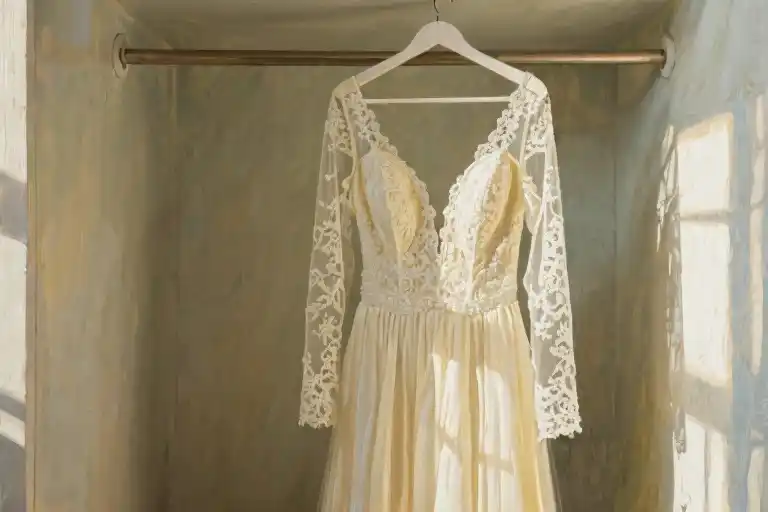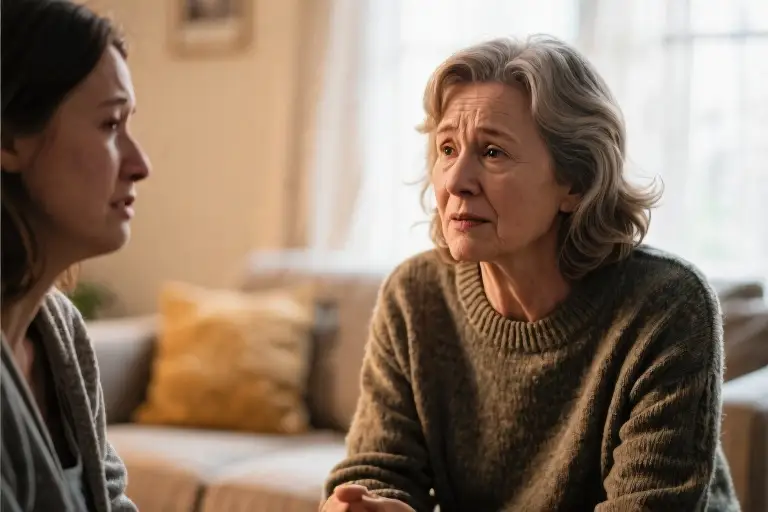The white dress hung in my mother’s closet like a ghost. Every time I passed by, its lace sleeves seemed to reach out—not to embrace, but to warn. At seven years old, I’d press my face against the cool fabric and smell the faintest trace of floral perfume mixed with something darker, something like the silence between my parents’ shouted words. While my friends played wedding with pillowcase veils, I folded mine into a parachute, ready for escape.
Growing up, I collected evidence against marriage like other girls collected pressed flowers. The way my father’s wedding ring left a dent on the kitchen table after he threw it one night. The photo album where my parents’ smiling faces slowly dissolved into stiff holiday card poses. My aunt’s emergency phone call from a motel parking lot, whispering about credit card statements and unfamiliar perfumes. These weren’t abstract fears—they were fingerprints on my understanding of love, smudging every romantic fantasy before it could fully form.
Yet even as I recoiled from weddings, I craved love with a hunger that scared me. I’d watch elderly couples sharing ice cream cones at the park, their wrinkled hands brushing as they passed the napkin, and feel a pang so sharp it blurred my vision. That’s when I realized: my terror wasn’t of commitment, but of counterfeit connection. The real nightmare wasn’t saying “I do”—it was saying it to someone who’d one day say “I don’t” to everything we’d built.
What makes marriage frightening isn’t the ceremony or the paperwork. It’s the terrifying vulnerability of handing your heart to someone who holds the power to keep it safe or crush it casually—and having no way of knowing which they’ll choose years later, when the champagne flutes are packed away and life shows up with its mundane storms. The true test of love isn’t surviving a wedding day, but surviving the thousands of ordinary days that follow, when staying feels less like a choice and more like a habit.
Now I see it clearly: the problem was never marriage. It was the illusion that love is something you promise once, rather than something you prove daily. That realization didn’t erase my fear, but it gave it a new address—away from the institution, and onto the individuals who enter it carelessly. Perhaps that’s the healthiest fear of all: not of weddings, but of the people who treat them like finish lines rather than starting gates.
The Seeds of Fear
Growing up, I learned about love from the silence between my parents. Their marriage was a masterclass in how affection erodes—not with dramatic explosions, but through countless unspoken disappointments. I remember finding my mother’s anniversary gift receipt in the trash one year, the price tag still attached. The next week, that same gift became ammunition in an argument about household budgets. Their wedding album gathered dust while medical bills piled up on the dining table where they used to hold hands.
This was my normal. The way their voices gradually lost warmth, like a radio signal fading into static. How “good morning” became just a noise between two people sharing a kitchen. I catalogued these changes with a child’s helpless precision—the disappearing pet names, the cancelled date nights, the way my father started sleeping on the couch without explanation.
Outside our home, I witnessed other versions of this unraveling. My college roommate Jessica had parents who hosted legendary dinner parties—the kind where everyone toasted to their “#couplegoals” marriage. Two months after their 25th anniversary cruise photos flooded social media, their divorce papers quietly appeared on Jessica’s childhood fridge. Then there was Mark from my first job, who kept his wedding ring on through three different affairs before his wife finally changed the locks.
These weren’t exceptions; they were patterns. The common thread wasn’t bad marriages—it was people who stopped choosing each other. The boyfriend who ghosted after my cancer scare. The friend whose husband traded her in for a “newer model” after her mastectomy. Everywhere I looked, promises dissolved like sugar in lukewarm tea.
What terrified me wasn’t the concept of marriage, but the human capacity to abandon what we once cherished. The way someone could look at you across a breakfast table with the same eyes that once cried at your wedding vows, and now only register annoyance at how loudly you chew your toast. That moment when “forever” becomes “just until something better comes along.”
Yet in this fear, I began noticing something else—the quiet counterexamples. My aunt who still brings my uncle coffee exactly how he likes it after 42 years, despite his Parkinson’s tremors. The elderly neighbors who hold hands during their evening walks, their steps synchronized after six decades. These relationships shared a common language of small, persistent choices—the antithesis of my parents’ grand but fragile romance.
Slowly, I understood: The problem was never marriage itself. The real danger lies in walking down an aisle toward someone who loves the idea of you more than the reality of you. Someone who mistakes infatuation for endurance, or sees commitment as a transaction rather than a daily decision. That’s the fear we should name—not fear of marriage, but fear of choosing poorly when our hearts are drunk on champagne and rose petals.
The Real Monster
Wedding dresses don’t betray people. Diamond rings don’t whisper lies. Floral arrangements never walked out on anyone after twenty years. The terrifying truth I’ve learned isn’t about marriage as an institution—it’s about the human being standing beside you when the music fades.
Three shadows lurk behind every failed ‘happily ever after’:
The Communication Ghost haunts relationships long before they collapse. I’ve watched partners develop entire sign languages of avoidance—sudden work calls during difficult conversations, mysterious headaches when accountability knocks, that vacant smile when real feelings need addressing. My childhood home had whole weeks where the only sounds were cabinet doors closing too hard and televisions turned up too loud.
The Double-Tongued Promiser speaks in romantic sonnets during good times but forgets the dictionary when storms come. They’ll pledge eternal devotion over champagne, yet vanish when you need a ride home from chemotherapy. I kept a friend’s wedding program where they’d handwritten ‘Through sickness and health’—two years before leaving during her postpartum depression.
The Stagnant Soul mistakes wedding vows for graduation certificates. Relationships either grow or decay; there’s no parking option. My cousin’s husband still acts like it’s 2012—same jokes, same emotional range, same refusal to discuss finances while their savings account bleeds dry. The scariest realization? People don’t usually change until pain forces them to.
Here’s what no one plants in the wedding bouquet:
- That gorgeous venue won’t mediate your arguments
- The cake’s sweetness can’t mask bitter resentment
- Photographs freeze moments, not commitment
When I finally understood this, my fear shifted. The question stopped being ‘Is marriage scary?’ and became ‘Does this person have the courage to grow with me?’ Because lifelong love isn’t about finding someone perfect—it’s choosing someone willing to keep becoming better together, long after the last wedding guest has gone home.
The Person Worth Walking Toward
A wedding lasts a day. A marriage lasts a lifetime. Between those two points stretches the uncharted territory where love is tested not by grand gestures, but by countless ordinary moments. This is where you discover what your partner—and your relationship—is truly made of.
The Three Pillars of Enduring Love
1. Support During Life’s Low Tides
The way someone stands by you when you’re broken reveals more than a thousand romantic dates. Notice:
- Do they listen without rushing to fix things when you’re vulnerable?
- Can they sit with your pain instead of dismissing it with “cheer up”?
- When you lose a job, face illness, or grieve, do they show up with quiet consistency?
2. Patience in the Mundane
Love thrives in the unglamorous spaces between big moments. Watch for:
- How they handle delayed flights, burnt dinners, or traffic jams with you
- Whether they remember your “small” preferences (that you hate cilantro, fear elevators)
- If they can enjoy comfortable silences as much as lively conversations
3. Repair After Ruptures
Every couple fights; great couples fix. Observe:
- Do they take responsibility for their part, or weaponize your vulnerabilities?
- Can they say “I was wrong” without caveats?
- After conflicts, do they reconnect intentionally (a hug, making tea for you)?
The Unseen Testimonials
Forget judging love by curated social media posts. These overlooked interactions reveal more:
- The Waiter Test: How they treat service staff shows their inherent respectfulness
- The Family Test: Their patience with difficult relatives hints at future conflict skills
- The Exhaustion Test: Their behavior when sleep-deprived or stressed unveils raw character
A proposal can be planned for months. True commitment is proven in unscripted moments—when they think no one’s watching. That’s why the most promising sign isn’t how often they say “I love you,” but how they behave when angry, tired, or disappointed in you.
The Choice That Repeats Itself
Marriage begins with one “yes” at the altar, then requires a thousand more silent yeses afterward:
- Choosing to listen when they repeat the same story
- Choosing kindness when they snap after a bad day
- Choosing to stay curious as you both grow and change
Look for someone whose actions whisper “I choose you” long after the wedding music fades. Because forever isn’t declared once with rings—it’s built daily through mundane, magnificent faithfulness.
When the Flowers Wilt
The satin dress will yellow with time. The champagne flutes will gather dust in some forgotten cabinet. Those meticulously arranged peonies? They’ll crumple and brown within days, their petals scattering like forgotten promises across hardwood floors. This is the unspoken truth no wedding planner mentions: every element of that perfect day is designed to fade.
Yet in the quiet corners of ordinary life, I’ve glimpsed another kind of beauty—the kind that deepens when the spotlight dims. The elderly couple at the grocery store, his arthritic fingers still instinctively reaching to adjust her scarf. The way my neighbor still brings his wife coffee in bed after thirty years, the mug chipped from decades of morning rituals. These are the moments that reveal what love actually looks like when stripped of chiffon and string quartets.
We obsess over floral arrangements when we should be studying how someone arranges their priorities when life gets messy. Does your partner remember how you take your tea on exhausted Tuesday mornings? Will they sit with you in hospital waiting rooms with the same devotion they showed while picking out china patterns? These unglamorous scenarios are the real tests no one Instagrams.
That photo-perfect wedding kiss means nothing compared to the thousand unphotographed kisses exchanged over kitchen sinks, during flu seasons, after bitter arguments. Real commitment isn’t measured in carat weight but in how someone shoulders the weight of ordinary days—the school lunches packed, the bills paid during job losses, the silent understanding when you’re too tired for words.
So ask yourself this: When the last guest has departed and the dress is preserved in some attic box, who do you want standing beside you? Someone who basks in spotlights or someone who remembers to leave the porch light on? Someone who loves the idea of you or the reality—complete with morning breath and bad moods and all the unpoetic human frailties?
The most breathtaking love stories aren’t those that begin with dramatic proposals. They’re the ones where two people keep choosing each other long after the glitter settles, where “forever” gets quietly reaffirmed in grocery lists and flu medicine runs. That’s the kind of love worth walking toward—not just down an aisle, but through all the ordinary, extraordinary days that follow.
When the Music Stops
The last champagne flute has been washed, the floral arrangements have browned at the edges, and the thank-you cards sit half-written in a drawer. This is when marriage begins—not when the orchestra plays your first dance, but when the silence settles in. That moment when you realize forever isn’t made of rose petals and sparklers, but of Tuesday night leftovers and flu season.
What stays when the wedding trappings fade reveals everything. The way they remember your coffee order after twenty years, not just during courtship. How they hold your hair back when you’re sick, not just your hand during vows. The silent understanding when you’re too tired for words, not the scripted ‘I dos.’ These unphotographed moments become the real architecture of love.
Commitment isn’t the glittering peak of a wedding cake—it’s the daily bread of choosing each other. Through traffic jams and tax seasons, through bad haircuts and worse decisions. The magic lives in mundane faithfulness: changing the car oil so you won’t be late for work, learning to make their childhood comfort food, folding the laundry socks they always pair wrong.
Some relationships crumble when the spotlight dims. The partners who thrived on grand gestures falter at daily kindnesses. But others—the real ones—grow roots in ordinary soil. Their love becomes like breath: invisible, essential, sustaining life without fanfare.
So let the wedding photos yellow in their album. Let the cake topper gather dust. The truest measure of love isn’t preserved in satin and silver, but in the wear patterns of shared life—the couch dent where you always sit together, the chipped mug they refuse to replace because it’s yours.
Marriage isn’t the finish line; it’s the starting block. Not the trophy, but the training. Not the fireworks, but the hearth. And when the last wedding guest has gone home, when the dress no longer fits and the rings bear scratches—that’s when you’ll know if you built something real.
The marriage certificate fades. The daily choices remain.
What small, uncelebrated act of love has stayed with you longest? Share in the comments—let’s honor the quiet heroes of real relationships.





